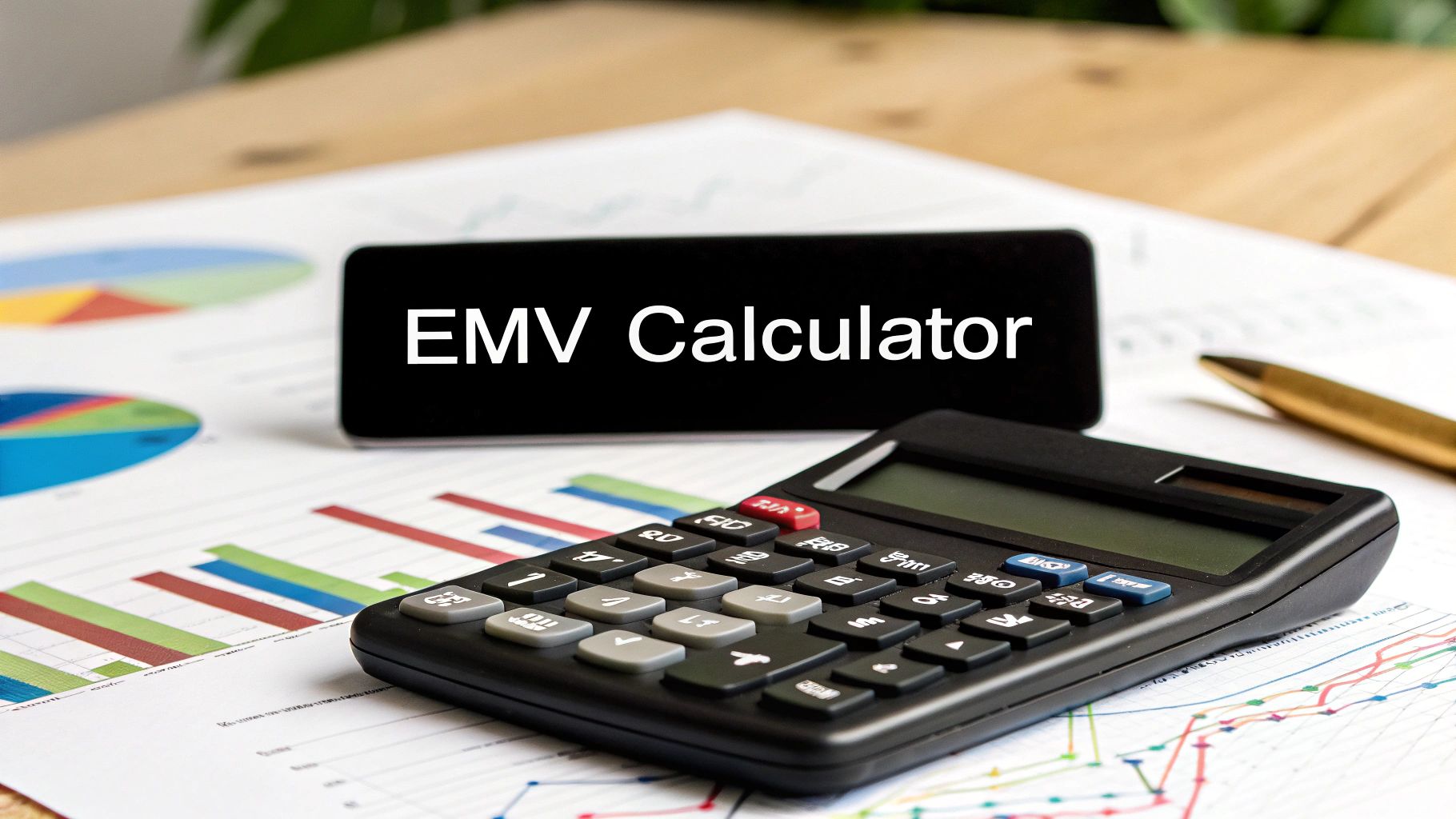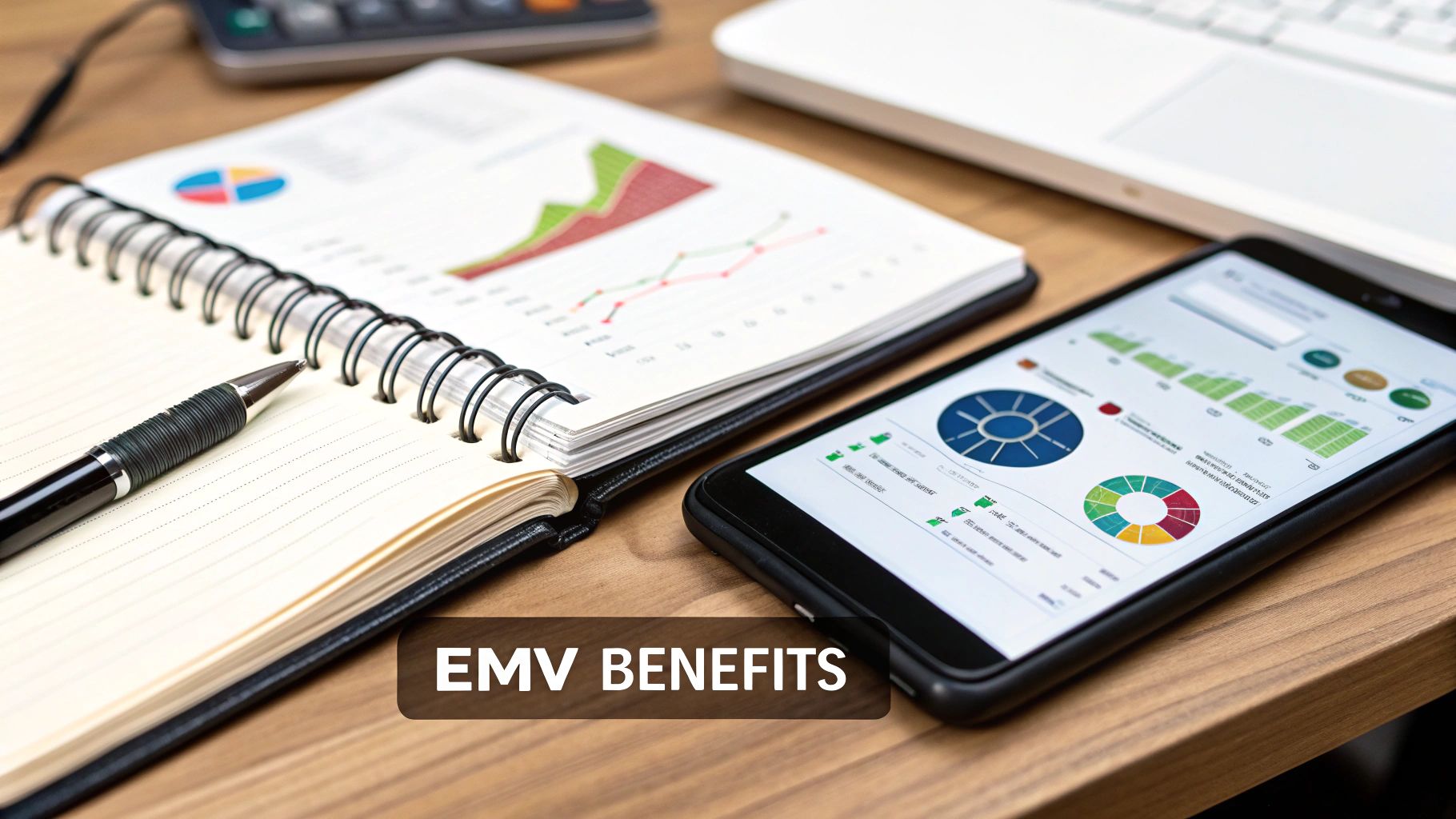Questions & Answers
We're here to help you get the most out of viral.app.
Mike Schneider
Co-Founder
Learn how to calculate the dollar value of your organic marketing efforts and prove your ROI to stakeholders.

Think of an Earned Media Value calculator as a translator. It takes all the fuzzy, hard-to-pin-down wins from your organic marketing—like social media shout-outs, press mentions, and influencer posts—and converts them into a cold, hard dollar figure.
It answers the question: "If we had to pay for this same level of exposure with ads, what would it have cost us?"
Picture this: you're in a meeting with your CFO, trying to explain why that viral TikTok video was a massive success. You can talk about views and likes all day, but those numbers don't always connect with someone focused purely on budget and ROI.
This is exactly where Earned Media Value (EMV) becomes your secret weapon. It translates that organic marketing buzz into the one language everyone in business understands: money.
Let’s say your brand gets a mention in a big online magazine. That’s great news, but what is it actually worth? An earned media value calculator takes the estimated audience of that article and multiplies it by what it would typically cost to run an ad on a similar site. Just like that, your "free" press hit now has a real, tangible value you can slap on a report.
At its heart, EMV is all about putting a standardized price tag on publicity you didn't pay for. It captures the value of all that organic exposure that builds your brand's reputation and gets you in front of new eyeballs.
Some of the most common sources of earned media include:
To really get a feel for EMV, it helps to have a solid grasp of core video engagement metrics, since these are the raw ingredients for many modern EMV formulas.
So, how does the math actually work? The core idea is simple: equate your organic results to what they would have cost in the world of paid advertising. Below is a quick breakdown of the key inputs an EMV tool uses and their paid media counterparts.
| EMV Input Metric | Description | Paid Media Equivalent |
|---|---|---|
| Impressions | The total number of times your content was seen. | CPM (Cost Per Mille/Thousand) |
| Video Views | The number of times a video was played. | CPV (Cost Per View) |
| Engagements | Likes, comments, shares, and saves. | CPE (Cost Per Engagement) |
| Clicks | Clicks on a link within the content. | CPC (Cost Per Click) |
Most EMV calculations start with a baseline formula that multiplies total impressions by a standard Cost Per Thousand Impressions (CPM). A common benchmark is a $35 CPM, which reflects a general average for reaching 1,000 people with paid ads in major markets. From there, the formula gets more sophisticated by factoring in the value of each engagement.
By assigning a dollar figure to your organic wins, EMV provides a powerful tool for proving the value of PR, social media, and influencer marketing—efforts that have historically been difficult to measure financially.
This gives you the power to put your earned media results side-by-side with your paid ad spend. It's the ultimate way to show just how much value your team is really driving.
Every earned media value calculator, at its heart, runs on a formula. The whole point is to turn abstract wins—like shares, views, and comments—into a concrete dollar figure that everyone can understand. While the math can get pretty deep, most models boil down to two core approaches. One is all about reach, and the other is focused on audience interaction.
The old-school method is impression-based. It’s super straightforward: you just take the total number of impressions (how many eyeballs saw your content) and multiply it by a standard CPM (Cost Per Mille, or the cost for a thousand impressions). So, if a blog post gets 100,000 impressions and your going rate for a CPM is $10, its baseline EMV is $1,000. This gives you a quick, high-level number for brand exposure.
But let's be real—just because someone saw your content doesn't mean it actually landed. And that's where the more sophisticated engagement-based formula comes into the picture.
An impression-based model sees all views as equal. But we know that's not true. A person who takes the time to write a thoughtful comment is worlds more valuable than someone who just scrolls past your post without a second thought. The engagement-based approach gets this, assigning a specific dollar value to each type of interaction. It recognizes that actions speak way louder than simple views.
This shift in thinking mirrors a larger trend. People trust authentic buzz from real sources way more than they trust a paid ad. To reflect this reality, savvy marketers started putting a price tag on different user actions. If you're curious about how these benchmarks came to be, it's all based on extensive industry research and analysis.
Here are some common industry benchmarks you’ll find baked into any decent earned media value calculator:
With these values, an Instagram post that triggers thousands of comments is correctly valued much, much higher than a post that got a ton of reach but crickets in the comment section.
This map here shows you exactly how brand mentions and direct engagement both flow into the final value.

As you can see, true EMV is a mix of both visibility (the mentions) and genuine audience connection (the engagement).
So, which formula is the "right" one? Honestly, it's a trick question. The answer is neither—at least not on its own. If you only look at impressions, you're missing the whole story on interaction quality, which can be totally misleading. But if you only focus on engagement, you might be undervaluing a campaign that delivered massive, brand-building reach.
The most accurate and defensible picture of your campaign’s true worth comes from a holistic approach. A modern earned media value calculator combines both models, using impressions as a baseline and then adding the weighted value of each engagement.
This hybrid model gives you the best of both worlds. You get a single, comprehensive number that respects both the sheer breadth of your reach and the genuine depth of your audience's connection. And that's a far more reliable way to measure your marketing success.

Getting a final number from an earned media value calculator is just the starting line. The real power comes from what you do with that figure. For today’s marketing leaders, EMV is much more than a simple report card—it's a strategic tool for proving your worth, securing budgets, and outmaneuvering the competition.
Imagine trying to convince your company’s leadership to invest more in your influencer program. Stories about brand love and follower counts are nice, but they don’t always get you the financial buy-in you need.
Now, picture walking into that same meeting with a different story.
One marketing manager did just that. By calculating her influencer program's EMV, she proved it delivered $150,000 in equivalent ad value on a $100,000 spend. She then compared this to a paid ad campaign that cost the same but only generated $90,000 in value. The argument was crystal clear.
The result? She secured a 50% budget increase for her next influencer campaign.
This story gets to the heart of why marketers swear by EMV: it speaks the language of the C-suite. By putting a dollar figure on your organic success, you can directly compare its efficiency against every other marketing channel.
This shifts the conversation from "we got a lot of shares" to "our organic efforts delivered a 1.5x return compared to paid ads." That kind of talk is crucial for justifying your team's existence and securing the resources you need to grow. To go deeper, it's helpful to understand the complete picture of social media ROI measurement, where EMV plays a key part.
EMV transforms your marketing department from a cost center into a value-generation engine. It’s the data that proves your team isn't just spending money—it's making smart, high-return investments.
Beyond internal reporting, agencies and brands use EMV for sharp competitive analysis. By running the same calculations on a competitor's public mentions and social engagement, you gain powerful insights into their market presence and campaign success.
Suddenly, you can answer critical questions like:
This intelligence lets you adapt your strategy on the fly, spot partnership opportunities, and make smarter bets on where to invest your next marketing dollar. For those focused on influencer marketing, tracking this data is essential for understanding the true ROI of influencer marketing compared to your rivals.
It turns a simple metric into a vital source of competitive intelligence.
Alright, enough with the theory. Let's get our hands dirty and see how this actually works.
Knowing the formulas is one thing, but the magic happens when you start plugging in your own numbers. This walkthrough will show you exactly how to use the built-in earned media value calculator on viral.app. We're going to turn your campaign's raw performance data into a simple, powerful dollar figure that speaks volumes.
It wasn't always this easy. Marketers used to spend ages trying to pin a financial value on their organic wins. Thankfully, modern tools have evolved. Today’s calculators can pull data from giants like Instagram, TikTok, and X (formerly Twitter), automatically assigning a value to every like, comment, and share. If you're curious about how we got here, it's worth a look at the history of EMV measurement tools.
First things first, you need to gather your raw performance data. We designed the viral.app calculator to be dead simple, with clearly labeled fields for every important metric. You don't need a data science degree—just grab the final numbers from your social media analytics reports.
Here’s the data you'll need to input:
Just drop these numbers straight into their matching fields in the calculator.
You'll see a clean, simple interface for your data, just like this:
The whole point is to get you from data entry to results as fast as possible, without any guesswork.
Our calculator comes loaded with industry-standard benchmarks, which are a great starting point. But for real accuracy, you need to customize. Tailoring the cost values to your specific industry or recent campaigns is what gives your final EMV number its credibility.
Think about it: the cost for 1,000 impressions (CPM) in the hyper-competitive beauty space is way different from what you'd pay in a niche B2B software market. Adjusting these inputs to match your reality is what makes the result truly meaningful.
Pro Tip: Don't have your own cost data handy? A great trick is to use the average CPM and Cost Per Click (CPC) from your own paid ad campaigns. This grounds your EMV in what your company actually pays for eyeballs, making the final number rock-solid and easy to defend.
This small tweak transforms the calculator from a generic tool into your own personalized analytics engine.
Once your metrics are in and your costs are customized, the calculator gets to work. Instantly, it crunches the numbers and spits out your final Earned Media Value. This single, powerful figure represents what you would have had to pay in advertising to get the same level of organic reach and engagement.
Your results are displayed clearly, giving you the total EMV so you can:
With this data in hand, you’re no longer just talking about likes and shares. You’re talking about real financial impact.

Anyone can plug numbers into an earned media value calculator and get an answer. That's the easy part. The real challenge is producing a credible, defensible number that actually means something under scrutiny.
It all comes down to a few key practices that separate flimsy vanity metrics from professional, strategic analysis. Get them wrong, and your impressive-looking EMV figure will crumble under the first tough question.
The single most common mistake? Using generic, out-of-the-box cost values. Every industry is its own world. The cost to reach 1,000 potential customers for enterprise software is wildly different than for a fast-fashion brand. Relying on a one-size-fits-all CPM or CPE will instantly undermine your credibility and give you a warped result.
To get it right, you have to anchor your calculations in reality. Start by sourcing industry-specific benchmarks for your cost metrics. Even better, use your own data. Pull the CPM, CPC, and CPE values from your own paid ad campaigns. This makes your EMV a direct, apples-to-apples comparison against what your company actually pays to get in front of people.
Once you've set your benchmarks, consistency is everything. You absolutely have to use the same methodology across all your campaigns. If you change your cost-per-like value halfway through the year, you can no longer accurately compare performance over time. It breaks the whole model.
A consistent methodology transforms EMV from a one-off number into a powerful long-term metric. It lets you spot trends, identify your most valuable channels, and make strategic calls backed by real data, campaign after campaign.
Beyond that, don't stop at a single, monolithic EMV number. That's just scratching the surface. The real magic happens when you segment your data. Breaking down your EMV shows you which parts of your strategy are truly pulling their weight.
Finally, always remember that EMV is a main character in your reporting story, but it isn't the entire story. It’s brilliant for putting a dollar value on exposure, but it doesn't capture everything.
Your EMV figures should always be presented alongside other critical KPIs like conversion rates, brand sentiment, and lead generation. This gives you—and your stakeholders—a complete, 360-degree view of your marketing impact. For a deeper dive, check out our guide on how to measure social media ROI to get the full picture.
Figuring out your earned media value is just the start—it's not the finish line. The number itself is only a piece of the puzzle. Its real power comes alive when you use it to build a smarter strategy and prove just how much impact your team is having. This is where your earned media value calculator goes from a simple measurement tool to your strategic compass.
The first move? Data storytelling. When you’re in front of executives, don't just throw a number at them. Frame your EMV as a direct reflection of ROI. Show them how your organic work is either keeping pace with or flat-out beating what you’re spending on paid ads. For example, pointing out that an influencer campaign brought in $50,000 in EMV from a $10,000 investment makes the value crystal clear.
Your EMV data gets even more interesting when you start looking at it over time. By tracking trends, you can pinpoint exactly which content and channels are your heavy hitters.
When you connect these dots, EMV starts guiding your marketing decisions toward what’s already proven to work. It’s the key to making smarter, data-backed moves that deliver undeniable value and strengthen your campaign reporting.
This kind of strategic thinking is a huge part of effective social media campaign reporting. It helps you build a rock-solid case for your next big marketing push.
As you start digging into Earned Media Value, a few questions pop up almost immediately. Getting these sorted out is key to building a measurement strategy you can actually trust. For many marketers, the first hurdle is a classic mix-up between two very similar metrics.
It's the age-old reach vs. impressions debate. Think of it like a billboard on a busy highway. Reach is the number of unique cars that drive past it. Impressions are the total number of times the billboard was seen—that includes the commuter who drives past it twice a day, every day.
For calculating EMV, impressions are almost always the way to go. Why? Because the ad world runs on impressions. Paid ads are sold on a CPM (cost per thousand impressions) basis. Using impressions lets you make a clean, apples-to-apples comparison between your earned media and what you would have paid for it.
The right timing depends entirely on your goals. There’s no single right answer, but here are some simple rules of thumb I’ve found work best:
You bet. While today’s earned media value calculators are built with the digital world in mind, the basic idea works just as well for traditional media. You're just swapping out the metrics.
For instance, if your brand gets a mention in a print magazine, you’d use the magazine’s circulation number as your "impressions." Then, you'd multiply that by the cost of buying a similar-sized ad in that same publication.
The logic holds true for TV appearances, event sponsorships, or radio spots. By adapting the formula, you can pull everything under one roof and get a single, unified view of your media value, both online and off.
Ready to stop guessing and start measuring? The viral.app platform provides the tracking and analytics you need to prove the value of your video marketing on TikTok, Reels, and Shorts. Discover how our tools can automate your influencer marketing and deliver clear, actionable insights today.
We're here to help you get the most out of viral.app.
Become an expert in UGC marketing today leveraging our industry knowledge and unique tools.